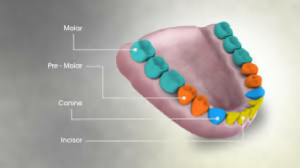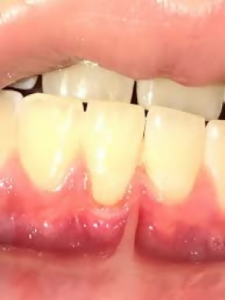 What are the differences in root canals in molars vs. incisors? The repository of hard tissue of your dental pulp can take on various shapes and configurations. This is what makes a thorough knowledge of your tooth morphology, detailed exploration of tooth interior, and careful radiograph interpretation mandatory prerequisites for a successful root canal treatment. Illumination and magnifications are essential aids when it comes to achieving this goal. That is to say, having sufficient knowledge of tooth’s internal anatomy before undergoing any endodontic treatment is one of the vital steps you must take.
What are the differences in root canals in molars vs. incisors? The repository of hard tissue of your dental pulp can take on various shapes and configurations. This is what makes a thorough knowledge of your tooth morphology, detailed exploration of tooth interior, and careful radiograph interpretation mandatory prerequisites for a successful root canal treatment. Illumination and magnifications are essential aids when it comes to achieving this goal. That is to say, having sufficient knowledge of tooth’s internal anatomy before undergoing any endodontic treatment is one of the vital steps you must take.
Root canal therapy is for removing bacterial infection from root canal to prevent reinfection or to protect the natural tooth. When plaque is build up on your tooth, it increases the risk of developing cavities. Cavities cause inflammation and infection in the tooth that is necessary to remove to disinfect the tooth. Although root canal treatment is one of the common procedures that millions of people undergo each year, it may entail risks of dental problems if not treated properly.
It is worth mentioning that the correct diagnosis of root canal infection depends on root morphology. For instance, knowing the difference in root canal in molars and incisors may have a significant impact on treatment’s success. You might not have heard it before, but location of your teeth can have a considerable effect on your root canal treatment.
If you think you do not have sufficient knowledge of tooth anatomy, their morphology, and its impact on root canals, we have you covered here.
How Does the Dentist Determine Tooth Roots and Canals?
There is no denying that variation in the strength of root canals play an extremely important role in the successful endodontic treatment. Precisely, dentists use three basic ways to determine the number of root canals.
· X – Rays
Long before a dentist begins performing root canal work, he/she takes dental x-rays. The two or three-dimensional pictures provide the dentist with substantial information related to the number of root canals patient’s tooth has. 3D imaging, especially, is widely used to determine many uncertainties about the anatomy of a tooth and the number of canals it has.
· Visual Inspection
Visual inspection is another vital part of the endodontic therapy that can help the dentist determines the number of canals a tooth has. Dentists create an access cavity to see pulp chamber of tooth and various canals.
It is worth noticing that not all teeth have the same number of canals, anatomy, and eruption patterns. Dentists need to consider anatomical limitations before performing any endodontic treatment, especially root canal of molars.
· Tactile Discovery
Using tactile discovery can help discover the total number of root canals. Dentists first clean the nerve space using root canal files. These files work up and down in the root canal system of the tooth, giving dentists a clear idea of its anatomy.
Different in Root Canals: Incisors vs. Molars
 As mentioned earlier, the correct diagnosis of root canal depends on its morphology and determination of number of root canal. Figuring out this is of utmost importance when it comes to carrying out a successful root canal treatment.
As mentioned earlier, the correct diagnosis of root canal depends on its morphology and determination of number of root canal. Figuring out this is of utmost importance when it comes to carrying out a successful root canal treatment.
It is because not all teeth are easy to access due to their anatomy and limitations. If a dentist does not know the anatomy of a tooth, he/he will not be able to measure the bacteria within the tooth’s canals and its microanatomy. That means whether it is single-rooted incisor or five-canal molar, determining the exact number of root canals and their terminus is essential.
Although it cannot be over-generalize as clinical situations of each patient may vary, the single canal maxillary (front incisor) is easier as compared to multicanal molar.
Maxillary Incisors
Even though maxillary incisors are easier to treat due to their single root canal, it may have some serious etiology that can be traumatic. In such cases, the patients are young teens, which is another challenge as their teeth may have large root canals, and half-developed root ends. In addition, if patient has a complicated trauma history, they may suffer pulp canal obliteration. The condition can close the root canal space. In these cases, locating canal becomes very difficult for the dentists.
Lateral and maxillary incisors have a relatively long canal. They have a curve at apex, which is multiplanar. The apex on the curve lingual and distal often makes it difficult to clean root canal. Mandibular incisors have a small mesial-distal dimension and do not give any margin of error when dentist locate for pulp chamber.
Molars
Generally, maxillary molars are difficult to treat when it comes to performing a root canal. They often face dental complications, as they are located at the posterior location and have abnormal eruption pattern and occlusal anatomy. Dentists have to consider their anatomical limitations while performing their root canal. Their extraction is one of the common choices for dental practitioners.
Many mandibular molars have four major canals in which two are well-defined mesials, and the two dumbbell-shaped canals located in the distal root.
If your dentist is an expert and has expertise in the relevant field, he can perform the successful root canal using advanced techniques.
Dr. Young Bui at Bryant Park Endodontics has been treating patients with severe dental issues for many years. He is experienced and competent and knows when a tooth requires minimum intervention to retain its functional components.
To find out more information about root canal treatment, calls us at 646-434-1481 or visits our website https://youngbuidds.com/.
Young Bui, DDS
30 East 40th Street Suite 1201
New York, NY 10016
646-205-3045
Drendo4u@yahoo.com
